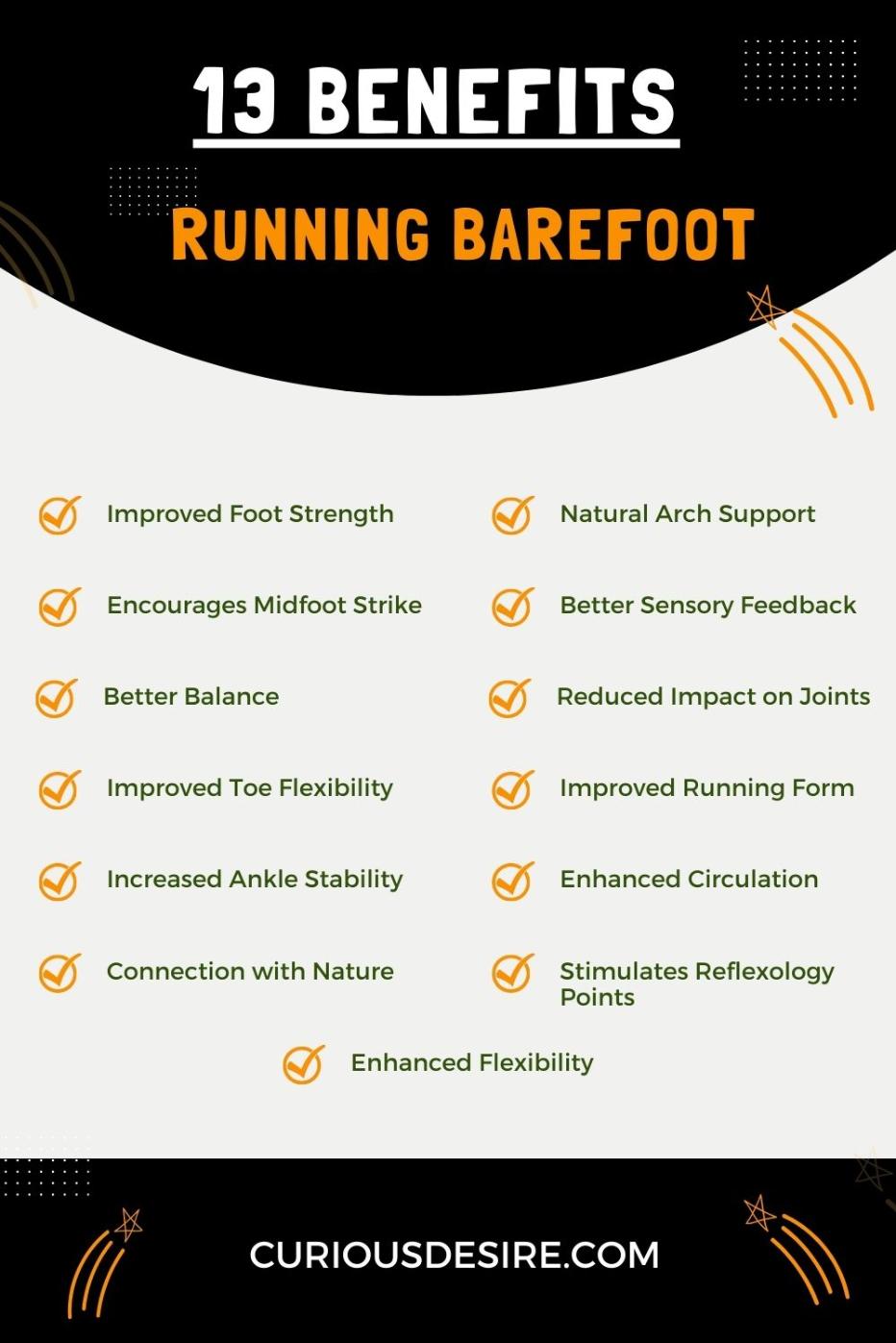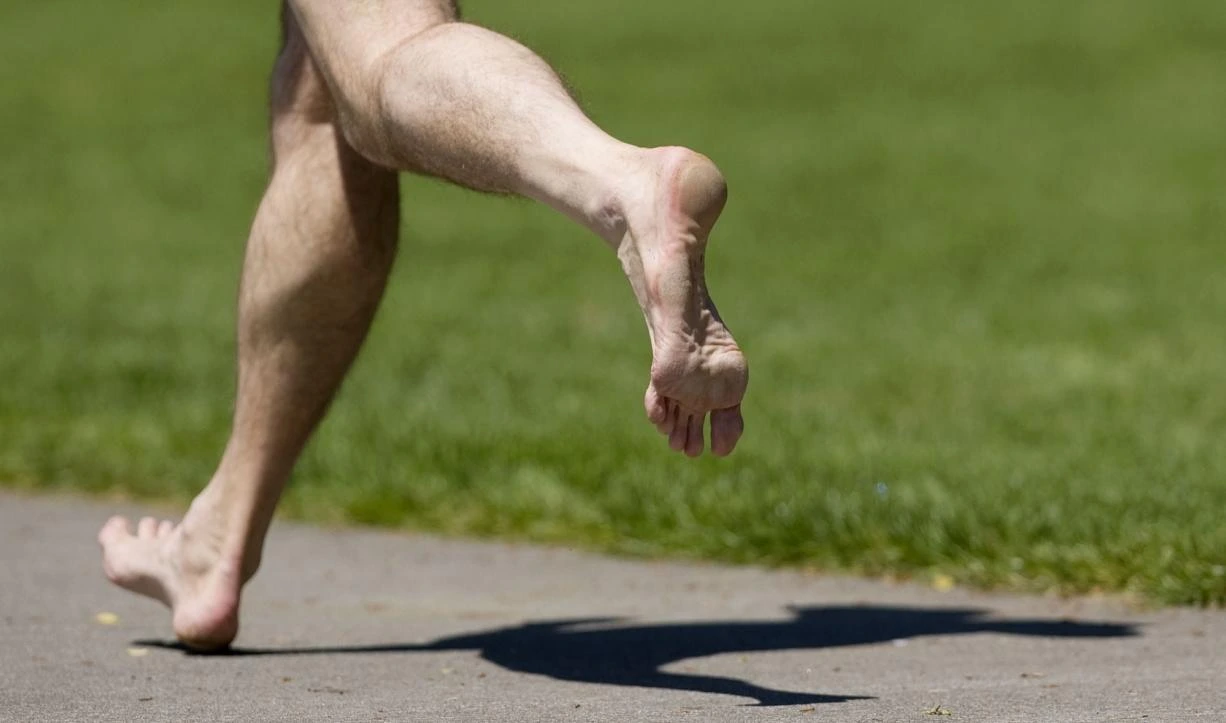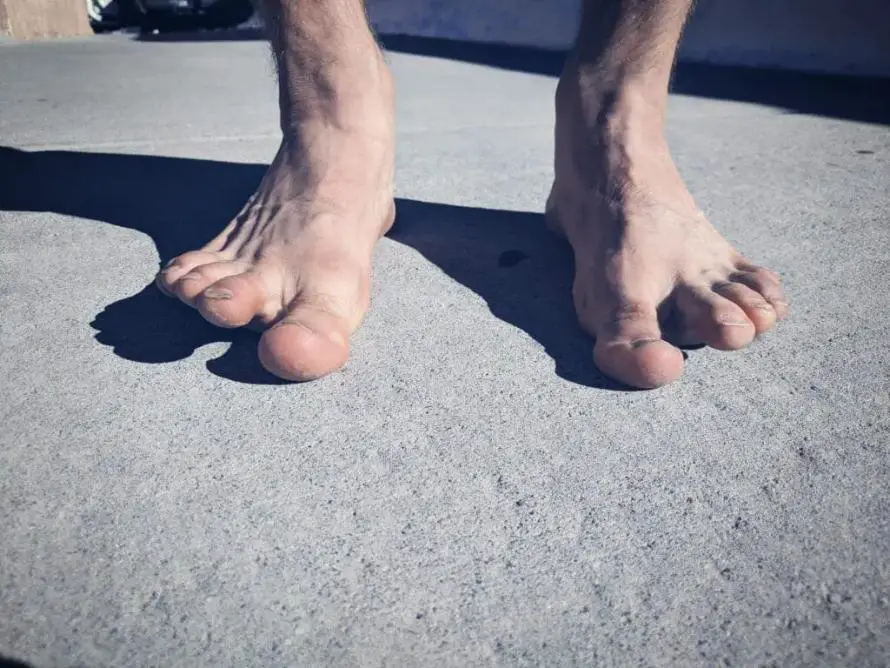Imagine feeling the earth beneath your feet, with every step connecting you directly to the ground. This is the essence of barefoot running—a practice as old as humanity itself, gaining attention for its simplicity and potential health benefits.
Recent studies have found a considerable growth in the popularity of running in the United States in the past few years.
In this post, we’ll uncover the straightforward advantages of running without shoes, delving into how this age-old activity can positively impact your physical well-being.
Here are the 5 most common benefits of running barefoot:
- Enhanced Foot Strength
- Improved Running Form
- Better Balance and Proprioception
- Reduced Joint Impact
- Heightened Sensory Experience
[toc]

Benefit 1: Improved Foot Strength
One remarkable benefit of running barefoot is its ability to significantly strengthen your feet’ muscles, tendons, and ligaments.
Traditional running shoes often offer excessive cushioning and support, potentially causing a weakening of these structures over time.
On the contrary, when you run barefoot, your feet must adapt to the natural contours of the terrain, involving a wider range of muscles.
According to research published in the Journal of Sport and Health Science, running without shoes, or in shoes with minimal support (4 mm offset or less), increases the use of the foot’s natural arch spring function. This heightened engagement places more demands on the intrinsic muscles, resulting in a stronger foot.
The increased activity contributes to the development of more robust and resilient foot structures, lowering the risk of injuries associated with weakness or imbalance.
Benefit 2: Natural Arch Support
Strengthening the muscles in the feet through barefoot running further contributes to the development of a more robust and natural arch support system.
Traditional footwear often provides artificial arch support, which may lead to weakened intrinsic foot muscles.
Allowing the arches to work naturally during barefoot running engages the muscles, promoting a stronger arch that can provide better support and stability.
Benefit 3: Encourages Midfoot Strike
Barefoot running often promotes a striking pattern where the ball of the foot touches the ground first.
This approach can minimize the impact on the heel, potentially reducing the risk of injuries linked to heel striking, like shin splints and stress fractures.
According to a study in Medicine and Science in Sports and Exercise, runners using a heel strike had 2.7 times more moderate and severe injuries compared to those using a forefoot strike.
Opting for a midfoot or forefoot strike is considered a more natural and biomechanically efficient way of running.
It aligns the foot with the body’s natural shock-absorbing mechanisms, potentially preventing injuries.

Benefit 4: Enhanced Sensory Feedback
Running barefoot opens the door for your feet to receive direct and nuanced sensory feedback from the ground.
According to expert podiatrist Dina Gohil, going shoe-free can work wonders for your proprioception—your body’s awareness of its position and movement.
In fact, the soles of your feet house numerous nerve endings crucial for proprioception.
Allowing these sensory receptors to engage more directly with the ground, barefoot running fosters an elevated awareness of your surroundings.
This, in turn, promotes a more connected and responsive running experience.
Benefit 5: Better Balance
Engaging in barefoot running is linked to an improved sense of proprioception.
When you run without the hindrance of thick-soled shoes, your feet can establish a more direct connection with the ground, allowing for more precise signals to be sent to the nervous system.
This heightened awareness significantly contributes to overall balance, enabling your body to swiftly adapt to changes in terrain or surface conditions.
According to insights from Lee Saxby in “Making Sense Of Barefoot Running,” going without shoes activates the smaller muscles in your feet, ankles, legs, and hips. These muscles are crucial in enhancing balance and coordination, making your movements more agile and responsive.
Benefit 6: Reduced Impact on Joints
Advocates of barefoot running argue that it may reduce the impact on joints compared to running with traditional shoes.
Conventional running shoes often feature thick, cushioned soles that can alter natural running mechanics.
In contrast, barefoot running promotes a more natural stride, encouraging a forefoot or midfoot strike instead of a heel strike.
Research supports these claims. A study in the British Journal of Sports Medicine found that running barefoot has the potential to reduce stress on the knees and minimize shock absorption by the body.
The rationale behind this is that impact forces are distributed more evenly throughout the foot and lower leg when running barefoot, potentially lessening stress on the joints and decreasing the risk of injuries related to impact (source).
Benefit 7: Improved Toe Flexibility
Regular barefoot activity promotes greater flexibility in the toes.
Conventional shoes with narrow toe boxes may limit the natural movement of the toes, possibly resulting in problems like bunions.
Barefoot running permits the toes to splay and flex more freely, encouraging a natural and healthy alignment of the foot.
This heightened toe flexibility not only contributes to improved balance but also helps alleviate strain on the toes and forefoot.
Benefit 8: Improved Running Form
The striking pattern in barefoot running often encourages a more efficient and biomechanically sound running form.
Opting for a forefoot or midfoot strike may reduce the braking forces linked to a heel strike, resulting in a smoother and more energy-efficient running stride.
Over time, embracing this natural running form may enhance running efficiency.
Studies indicate that running barefoot can lead to a 4% increase in running efficiency and a reduced risk of certain injuries associated with improper biomechanics.
Benefit 9: Increased Ankle Stability
Running barefoot actively engages the muscles around the ankle joint, enhancing ankle stability.
A study supports this claim, indicating that standing ankle joint proprioception improves without shoes compared to wearing them.
This heightened stability, attributed to increased muscle involvement, also reduces the risk of ankle sprains and related injuries.
Benefit 10: Enhanced Circulation
Better circulation is a potential perk of barefoot running, as supported by a study from the Journal of Alternative and Complementary. This research suggests that going shoeless can actually enhance blood circulation.
By engaging muscles and promoting efficient blood circulation, this practice might contribute to better vascular health, potentially reducing the risk of issues linked to poor circulation.
So, besides the sheer joy of running, going barefoot might also be a stride toward healthier circulation.
Benefit 11: Connection with Nature
Running barefoot establishes a direct connection with the ground, offering a more authentic and sensory-rich experience.
This connection enables runners to sense the textures and temperatures of the terrain, adding depth to the overall running experience.
As Warnock discusses in her thesis, Barefoot Running: Feeling the World Through Your Feet, wearing shoes can diminish the feeling of the ground and the surrounding environment, as the foot is shielded.
Another study mentions, that walking barefoot outdoors allows children to connect with nature, potentially leading to more positive mental health outcomes.
Many enthusiasts value the freedom and proximity to nature that barefoot running provides, making it a more immersive and enjoyable exercise.
Benefit 12: Stimulates Reflexology Points
The soles of the feet are rich in reflexology points, and barefoot running may stimulate these points as the feet interact with different surfaces.
Reflexology is an alternative therapy that suggests certain areas of the feet correspond to specific organs and systems in the body. (source)
While scientific evidence on the benefits of reflexology is limited, some individuals find that stimulating these points through barefoot activity enhances overall well-being and relaxation.
Benefit 13: Enhanced Flexibility
Wearing traditional shoes can limit the natural movement of the ankles and overall feet, resulting in decreased flexibility over time.
As Dichary pointed out, “Extensive barefoot movement over the years has led to strong muscular attachments that anchor and stabilize the foot. In contrast, the average Western foot, accustomed to reliance on shoes, falls short in comparison.“(source)
The increased range of motion gained through barefoot running contributes to improved foot and ankle flexibility, potentially reducing the risk of injuries related to stiffness or limited mobility.
Running Barefoot Benefits FAQs
Is it better to run barefoot?
Running barefoot can have some benefits, such as improved foot and ankle strength, better balance, and a more natural running gait.
However, whether it’s “better” depends on individual preferences, running style, and the specific conditions in which you run.
What are the disadvantages of barefoot running?
Disadvantages may include an increased risk of injury, especially if you’re not accustomed to it, as well as a lack of protection from sharp objects or extreme temperatures.
Barefoot running may not be suitable for everyone, and it can take time for the body to adapt.
Is it good to run barefoot on the road?
Running barefoot on the road can be challenging due to potential hazards like debris and uneven surfaces.
It requires careful consideration of the environment and gradual adaptation to prevent injuries.
Why do humans run faster barefoot?
Running barefoot may enhance proprioception (awareness of body position), promote a more natural running form, and engage the foot’s natural arch and muscles, potentially leading to increased speed.
Does running barefoot make you stronger?
Yes, running barefoot can strengthen the muscles in the feet, ankles, and lower legs. It also encourages a more natural running stride, promoting overall strength and balance.
Does running barefoot increase memory?
There’s no direct evidence to suggest that running barefoot has a significant impact on memory.
Is barefoot good for the brain?
While there’s no direct correlation between running barefoot and brain health, regular physical exercise, including running, is generally beneficial for cognitive function and overall well-being.
How do you run barefoot properly?
Start gradually, on a soft surface, and pay attention to your running form.
Land on the midfoot, not the heel, and take shorter strides. Listen to your body and allow time for your feet to adapt.
What happens if you run barefoot?
Running barefoot engages the foot’s natural mechanics and can lead to increased strength, balance, and a more efficient running gait.
However, it also increases the risk of injuries if not done gradually and with proper form.
Is barefoot better than shoes?
It depends on individual preferences, running style, and the specific conditions.
Some people prefer the support and protection of shoes, while others enjoy the benefits of barefoot running.
Can I work out barefoot?
Yes, many people choose to work out barefoot, especially for activities like yoga, Pilates, or bodyweight exercises.
It can enhance stability and strengthen the muscles in your feet and ankles.
Do people run faster with shoes?
Running speed can be influenced by various factors, including individual biomechanics, fitness level, and training.
Some people may find that certain shoes provide them with better support and performance.
Do humans run faster on their toes?
Running on the toes can be part of a natural and more efficient running gait for some individuals, but it’s essential to have a balanced foot strike and not exclusively run on the toes to prevent overuse injuries.
Why can humans only run so fast?
Human running speed is limited by factors such as biomechanics, muscle structure, and energy consumption.
Evolutionary factors and the trade-off between running efficiency and other survival traits also play a role.
Why can some people naturally run faster?
Genetics, biomechanics, training, and overall fitness levels contribute to individual variations in running speed.
Some people may have a natural predisposition for running, while others may need more training to achieve similar results.
